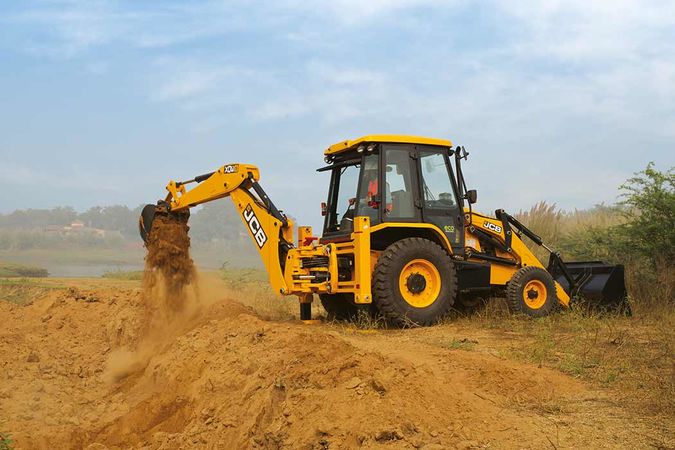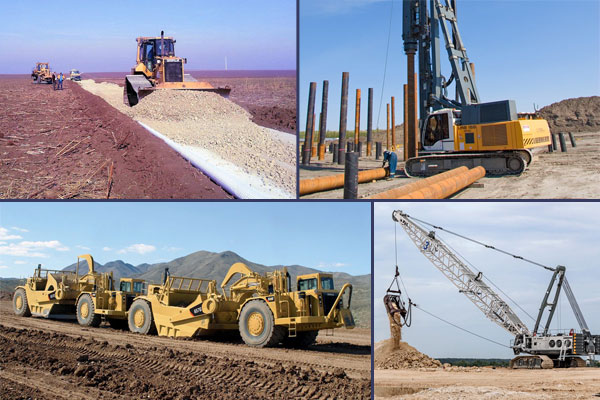The application of the infrastructure materials is not possible without a conveniently prepared subgrade. Without quality preparation of the surface and subgrade of the body, the effectiveness of the geosynthetics would be suppressed and their life would be much shorter. The use of heavy machinery thus becomes an important step in the implementation of infrastructure applications. The use of different products in implementing transport constructions cannot do without heavy machinery required for filling and removing soil, minor ground modifications, compaction, leveling and layer overlapping.
Different types of Heavy Machinery for Infrastructure Construction
Dragline Excavators for Infrastructure Construction
Modern large excavators use a dragline to pull a bucket by a wire cable. The operator lowers the bucket down to the material that is supposed to be excavated. The operator then draws the cable so that the bucket gets dragged along the ground surface and digs into the material. After a while, the operator releases the drag cable and lifts the bucket to the place where the material it scooped up will be dumped. New series draglines have a bucket capacity ranging from 76m³ to 116m³ and 5,800t to 7,500t of working weight.

Motor graders for Infrastructure Construction
New series motor graders are well-equipped models ideally suited for small-to-mid-size grading operations for municipalities, road maintenance and general construction. Their new engine solution delivers fuel-saving performance with minimal cost or maintenance from the operator and with the product assurance of ProCare, ownership and upkeep has never been easier. Models come standard with the productivity-boosting features operators want and are available as standard drive or AWD, and as machine control-ready for integrating into precision fleets. They are usually self-propelled machines with an adjustable blade.

Wheel tractor-scraper for Infrastructure Construction
The new generation wheel tractor-scrapers have the power, traction, and speed for reliable output in a variety of earthmoving applications. Scraper options include single-engine and tandem-engine open bowls, tandem engine push-pulls and elevator arrangements. The features, including high-pressure steering, engine over-speed protection, tire spin reduction, differential lock engagement protection, machine/ground-speed control, and a payload-estimator system are also built in modern wheel tractor scrapers. The new models incorporate several additional enhancements such as advanced Cushion Hitch hydraulic-system refinement, Auto-Stall assists, cab interiors feature a redesigned dash as well as visibility and operator comfort enhancements; maintenance etc.

Trenchers for Infrastructure Construction
Trenchers are designed for cutting narrow, straight trenches. Modern-day trenchers can produce trenches with perfect profiles in widths from 20 to 60 centimeters to a maximum depth of 2 meters. New age trenchers come with a wheel fitted with rim buckets, or with a boom or ladder on which an endless chain of buckets or scrapers revolves. The machine is self-propelled on rubber tires or crawlers (continuous metal treads driven by wheels). As the machine moves forward, it rotates the ladder or wheel so that the buckets dig at their forward edge. They dump onto a conveyor belt or a chute that piles the cuttings on either side. Trenching machines can be equipped to cut hard ground and even soft rock, but they encounter difficulty with boulders. Trenchers are very similar to excavators as both types of machinery can break and remove soil and rock from the ground. Unlike excavators, trenchers have the ability to remove soil in a continuous movement.

Compactors for for Infrastructure Construction
Hydrostatic travel drive systems in modern compactors have smooth directional changes between forward and reverse, without scuffing the material surface. Hydraulic motors are mounted directly to the rear wheel assembly, driven by a variable displacement hydraulic pump. Hydraulic power steering provides precise steering to maximize surface coverage with uniform tire coverage. Maintenance-free hydrostatic drive enables a smooth transition between forward and reverses direction without damaging the mat. Isostatic leveling cylinders keep the front tyres in even contact with the material surface at all times. Irregularities in the material are removed and excellent surface sealing is achieved. Manufacturers are offering eight-wheeled pneumatic tyre rollers that offer the smoothest compaction yet designed for roadway applications. High-performance compaction aids you to finish your job on time and within budget.
Dump Trucks for Infrastructure Construction
New generation dump trucks can transport heavy loads quickly, easily and cost-effectively. Available in rigid or articulated versions with state-of-the-art designs, they are built around a powerful engine and are exceptionally strong machines. They guarantee complete driving safety, even at high speeds. From the transmission system and chassis to the axles and suspension, all the components are designed to handle grueling daily stresses for maximum reliability. Dump Trucks are typically used for hauling material over the road or around a job-site. They typically feature a cab similar to that of a Truck Tractor but offer a hydraulic dump bed. Dump Trucks come in varying axle configurations, which typically limit the weight you are capable of hauling.

Pile driving machinery for Infrastructure Construction
Pile driving machinery is designed to align and hold piles in the correct position and to drive the piles into the ground. Machinery of this type can also be used for extracting piles from the ground. Pile-driving machinery includes a weight-lifting device and a driver, which is usually mounted on a pile driver or on a truck, tractor, railroad platform, excavator, or crane hoist. These are classified according to the principle used in operating the driver as striking, vibratory, or jacking. It is designed to align and hold piles in the correct position and to drive the piles into the ground. Equipment of this type can also be used for extracting piles from the ground.

Backhoes for Infrastructure Construction
Modern backhoes are powered by a better engine and deliver powerful performance and fast response time coupled with higher productivity and fuel savings of up to 13%. They are re-engineered from the ground up to deliver industry-leading backhoe breakout force, greater loader lift capacity/reach, and cab visibility. The new series Backhoe have robust robotically welded two-piece structural frame design results in great stability, performance and serviceability. Large box-section structures in high-stress areas such as the boom nose, foot and cylinder enhance the machine’s durability. The new heavy-duty front axle with double effect steering cylinder ensures all wheels remain in contact with the ground even on the roughest terrain, ensuring exceptional stability and reliability. The hydraulically shifted clutches allow the operator to change direction and travel speed on the go, while the control valves deliver smooth speed and direction shifts, resulting in smooth and accurate operation. The new tilting engine hood provides excellent access for maintenance.

Bulldozers for Infrastructure Construction
New bulldozers are equipped with a hydraulically operated horizontal blade for moving large quantities of earth, rock and other material. The dozer is mounted on tracks and uses its broad blade for land clearing, grading, excavating, placing and transporting materials. Bulldozer is equipped with a substantial metal plate used to push large quantities of soil, sand, rubble, or other such material during construction or conversion work and typically equipped at the rear with a claw-like device (known as a ripper) to loosen densely compacted materials. It is usually a crawler tractor. Bulldozers can be found on a wide range of sites, mines and quarries, military bases, heavy industry factories, engineering projects and farms.

Paver for Infrastructure Construction
New age pavers are designed to execute operations of Road repair and reinstatement, Bicycle path paving, car parks, decks, and Landscaping. The newer models give paving results of superior quality by having a heavier screed with tamper bars. They are designed to meet and surpass your needs in terms of precision, efficiency and ergonomics. The result is an impressively high paving performance, including the achievement of excellent compaction values.
Image Source: liebherr.com, deere.com, cat.com, blog.iseekplant.com.au, ammann, komatsuindia.in, jcb.com, naue.com


